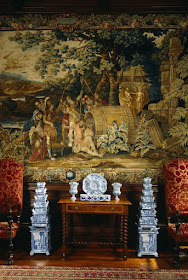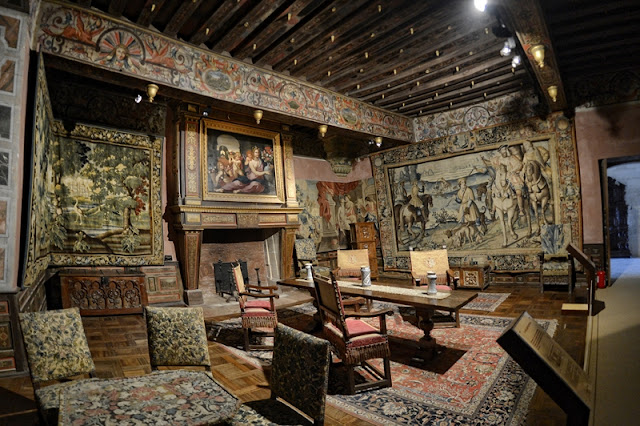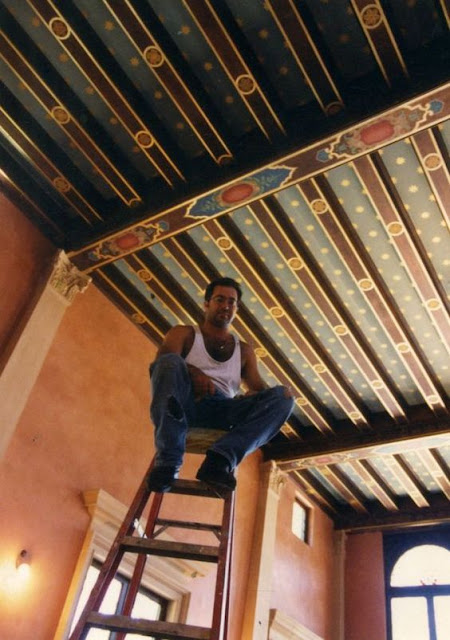Tulip Mania: a period in the 17th century where the exorbitant cost of tulip bulbs (recently introduced to the Netherlands from Asia through global trade) caused a frenzied trend as the flower became a status symbol, and the royal as well as the rich desired a means of growing and showing the tulip indoors. Hence the tulipiere or tulip holder. These large, floor-standing vessels with their ornate and pyramid-shape became an instant way to indicate the owner's wealth
Usually made of blue and white Delftware or Chinese porcelain, tulipieres were not designed as vases for cut flowers. Instead they originally were used to force tulip, hyacinth, or crocus bulbs to grow and bloom in the house.
Today tulipieres are used to hold tulip stems or blooms from other flowers. I can't imagine anyone who loves to grow flowers not coveting one. If you are in possession of one of these antique beauties, consideration yourself very fortunate as they can be quite expensive. However there are modern versions of the tulipiere in a variety of styles and shapes so get one and create your own lovely tablescapes.
Carolyne Roehm
The blue and white tulipiere is basically a tower shaped vessel dedicated to the presentation of the tulip flower. In the 17th century they were common pieces of decorative art that could often be found in the houses of European aristocracy. They are typically constructed to accommodate one single bulb per spout with a larger common water reservoir base.
The history of blue and white Delft pottery can be traced back to the foundation of the Dutch East India Company in 1602. All through the period known as the ‘Dutch Golden Age’ Delft ceramics produced tulipieres. In fact The popularity of the Delftware trade was actually contributed to the love of the tulip during this time.
After the advent of large-scale global trade in the 17th century, numerous flower bulbs from Asia, such as the tulip, crocus, and hyacinth became luxury items in Europe, and these bulbs remained an exotic novelty until the end of the 17th century. This made these beautiful blue and white tulipieres the perfect accessory of the day.
Via Town & Country Magazine
Beautiful twin blue and white Delft tulipieres in the Diogenes Room at Dyrham, Gloucestershire, UK .
Today the tulipiere is a showcase for the beautiful blooms of any flower. They are great accessories for foyers, dining rooms, hallways....the list goes on.
A majority of tulipiere are blue and white and often feature the shape of a pyramid or obelisk. It's design was influenced by the Porcelain Pagoda in Nanking, China.
Your home will reflect a bit of history when decorating with a tulipiere. These seventeenth century inventions for the growing of bulbs are still highly in demand even today.
Pretty as an objet d'art, a tulipiere will add a touch of style to your blue and white vignette.
A blue and white tulipiere looks marvelous as part of a tablescape or centerpiece. This one features a lady on top.
Of all the tulipieres I think the blue and white ones are the most desired. They are so pretty when used in groupings of other blue and white porcelain or Delftware.
A tulipiere full of flowers will instantly create a beautiful, balanced arrangement.
Antique blue and white tulipiere at the Victoria and Albert Museum c1690 made for Queen Mary from a design by Daniel Marot a French Huguet who fled to Holland.
The tulipiere is a great accessory for the Chinoiserie interior because of it's pagoda shape
It was trendy at the time to use tulipiere bouquets in the fireplace during the warmer months.
It was acceptable for a large tulipiere to have in excess of thirty sprouts. I think tulipieres look great when used with topiary as they are here in a fireplace at Chatsworth, the residence of the Dukes of Devonshire.
House & Garden, photographer Melanie Acevedo
A bit of holly added to a blue and white Delftware tulipiere will make a stunning Christmas display.
Or adorned with red blossoms a blue and white a tulipiere is perfect for the holidays.
Blue and white tuliperies are so beautiful when surrounded by other antiques in an old world vignette.
You can see how a tulipiere can make flower arranging a breeze. Fill up the water reservoir, place your cuttings in the holes and Voila!...... instant arrangement.
One can easily see from this image why the blue and white tulipiere or flower pyramid is a phenomenon that has been used for hundreds of years by royalty and aristocrats.
A rare Dutch delft blue and white tiered chinoiserie tulip vase.
via Flower Magazine
I love the purple coneflowers used in this tulipiere. This wildflower is perfect for a lovely light and airy interior.
These blue and white tulipieres show you what pretty accent pieces they can be even if you choose not to use them as vases.
Tulipieres come in assorted shapes and sizes and with little effort can create a beautiful display for any setting.
via Pinterest
Tulipieres are not all pyramidal. This antique blue and white one resembles a tureen and has stolen my heart!!
This blue and white tulipiere features dahlias instead of tulips....but that's OK!
While the tulipiere had it's heyday in the late 17th and early 18th centuries, it still remains a perennial favorite.
These Brunschwig fils Delft tulipiere vase lamps are not blue and white but had to share as they are also very chic and pretty.
If the 17-19th century blue and white Delft and Chinese pieces are a bit too ornate for your taste you might want to consider a contemporary tulipiere. They are still perfect for showing off your tulips and other garden blooms.
Decorating with today's modern tulipieres puts a contemporary spin on an old-world idea.
In the event that I have not credited the correct source of an image, please contact me at lisafarmerdesigns46@yahoo.com and I will be glad to correct it.
Click here to see the previous post
This blog post was published by Lisa Farmer
In the event that I have not credited the correct source of an image, please contact me at lisafarmerdesigns46@yahoo.com and I will be glad to correct it.




































































































